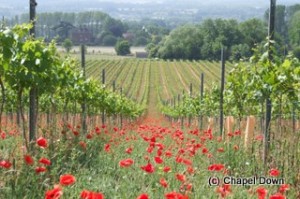Britain’s best bacchus, bubblies and more besides

Chapel Down
Judging at the English and Welsh Wine of the Year Competition, 2012 was a new and relished experience for me. I came away reinvigorated by the dynamism and freshness of the industry.
The nature of the judging beast means tasting notes are often brief and lacking some of the poetry that greater time and reflection allows, so what follows is a list of some of the wines I most enjoyed experiencing during the judging process.
I’ve long been a fan of bacchus, and this year more than a third (five) of the gold medals were awarded to this grape variety that expresses itself with fresh, zesty, grassy and steely flavours, and real substance and length in the best examples. It’s a crossing between (silvaner x riesling) x Muller-Thurgau, and it seems to have adopted all the best flavour characters of its parents.
Bolney Wine Estate, Bacchus 2011 (silver)
Bothy Vineyard, The Doctor’s Bacchus 2011 (silver)
Camel Valley Vineyard, Bacchus 2011 (gold)
Chapel Down, Bacchus 2011 (silver)
Chapel Down, Bacchus Reserve 2010 (gold)
Furleigh Estate, Bacchus Fume 2010 (gold)
Giffords Hall Vineyard, Bacchus 2011 (silver)
Lavenham Brook Vineyard, Bacchus 2010 (gold)
New Hall Vineyards, Bacchus 2011 (gold)
Nutbourne Vineyards, Bacchus 2011 (silver)
Sandhurst Vineyards, Bacchus Dry 2011 (silver)
Warden Abbey Vineyard, The Reformer 2010 (50:50 bacchus, reichensteiner) (silver)
I left the competition with much greater appreciation for madeleine angevine, which can be floral, citrusy, fresh and with some real density of soft white fruits, even a hint of white pepper. Though it’s well behind the plantings of some other Germanic varieties, it looks like it falls in behind bacchus in the still wine stakes:
Giffords Hall Vineyard, Madeleine Angevine 2011 (silver)
Oatley Vineyard, Jane’s 2010 (silver)
Yearlstone Vineyard, No. 6 2010 (with pinot blanc) (silver)
Three Choirs Vineyards, Midsummer Hill 2011 (madeleine angevine, with phoenix, reichensteiner, muller thurgau) (silver)
Three Choirs Vineyards, Annum 2011 (25% madeleine angevine, with schonberger, reichensteiner, phoenix, sieggerrebe) (silver)
Plus a selection from those Germanic varieties, the UK’s heritage grape varieties, as well as newer varieties such as phoenix and orion, some of which are finding a niche for themselves:
Astley Vineyards, Cirrus 2010 (mostly phoenix, plus sauvignon blanc and bacchus) (silver)
Denbies Wine Estate, Noble Harvest 2011, (ortega) (sweet) (gold)
Oatley Vineyard, Leonora’s 2010 (kernling) (silver)
Rose Bank Vineyard, Reichensteiner 2010 (silver)
Three Choirs Vineyards, Coleridge Hill 2010 (madeleine angevine, phoenix, orion) (silver)
The emergence of pink, both still and sparkling, was a encouraging revelation. I even felt I was beginning to see the emergence of two broad still pink styles: the more restrained, elusive ‘Provence’ style, and a plusher, crunchy ripe fruit style. Sparkling pinks had a heartening level of consistency about them.
Still rosé
Denbies Wine Estate, Chalk Ridge Rose 2011 (silver)
Kenton Vineyard, Rose 2011 (silver)
Nutbourne Vineyard, Blush 2011 (silver)
Portesham Vineyard, Pink 2011 (silver)
Sharpham Vineyard, Whole Berry Rose 2011 (gold)
Sparkling rosé
English Oak Vineyard, Chinkapin 2009 (silver)
The Mount Vineyard, sparkling rose 2009 (silver)
Ridgeview Wine Estate, Fitzrovia Rose 2009 (silver)
Ridgeview Wine Estate, Victoria Rose 2009 (gold)
Camel Valley Vineyard, Pinot Noir Rose Brut 2010 (gold)
The category of the highest expectation, white sparklers, took fewer golds (four) than bacchus. Varietal composition is an emotive subject for the industry, and one of the encouraging things here is that some winners are using fruit from classic traditional method varieties (chardonnay, pinot noir, pinot meunier), and others from UK heritage grape selections:
Bluebell Vineyard Estates, Hindleap Blanc de Blancs 2008 (gold)
Breaky Bottom Vineyard, Cuvee Alexandre Schwatschko 2008 (silver)
Furleigh Estate, Blanc de Blancs 2009 (gold)
Furleigh Estate, Blanc de Noirs 2009 (gold)
Furleigh Estate, Classic Cuvee 2009 (gold)
Gusbourne Estate, Blanc de Blancs 2007 (silver)
Gusbourne Estate, Brut Reserve 2007 (bronze)
Jenkyn Place Vineyard, Brut 2008 (silver)
Plumpton College, The Dean Brut NV (silver)
Meopham Valley Vineyard, 2008 (gold)
Sharpham Vineyard, Blanc 2009 (silver)
In a cool/cold climate such as the UK, red wines will always be a niche segment. The industry is certainly getting better, but there’s still some way to go. My favourite wasn’t even pinot noir:
Biddenden Vineyard, Gamay 2011. (Silver medal)
For a full set of results see the English Wine Producers’ website.



